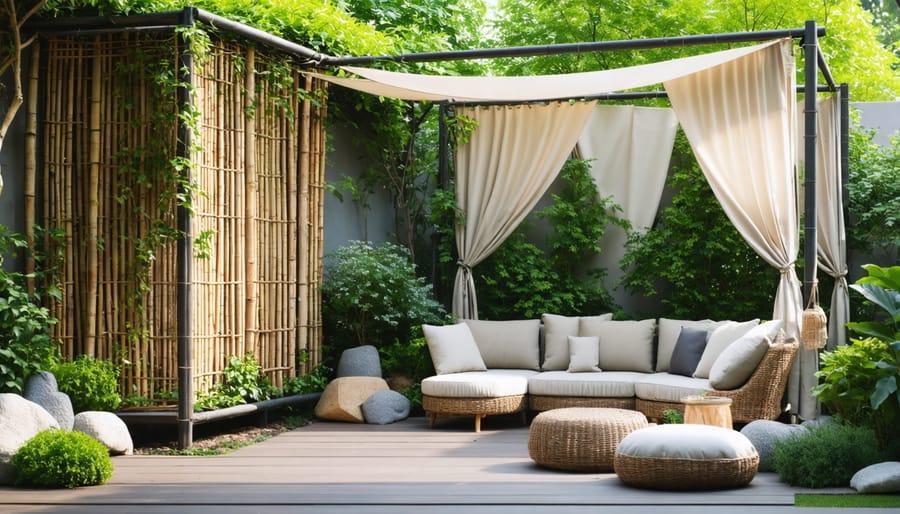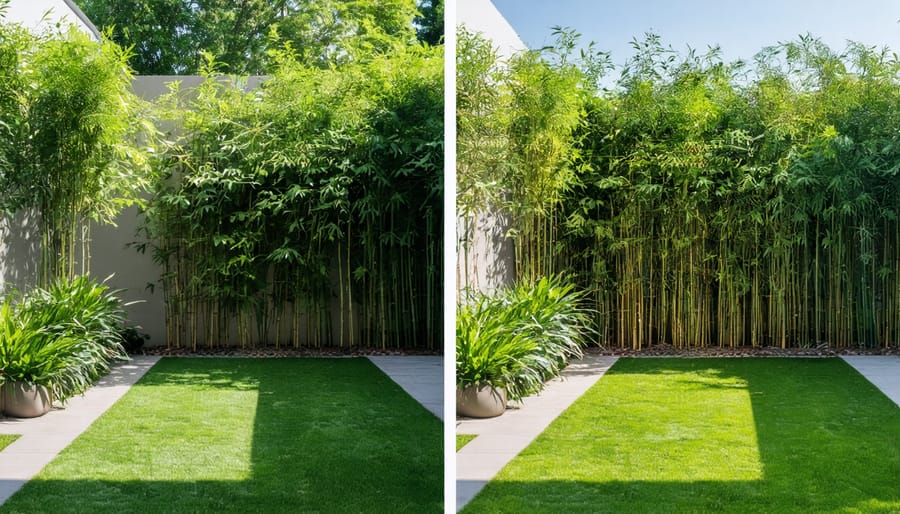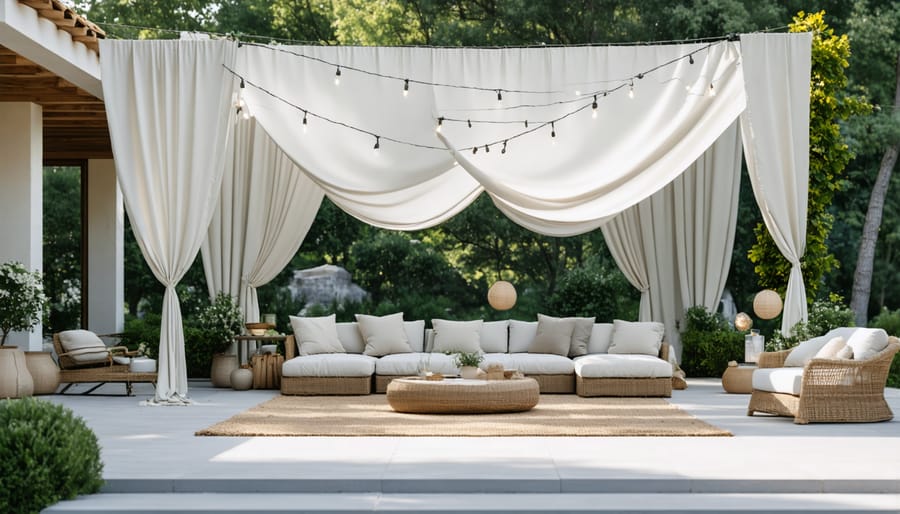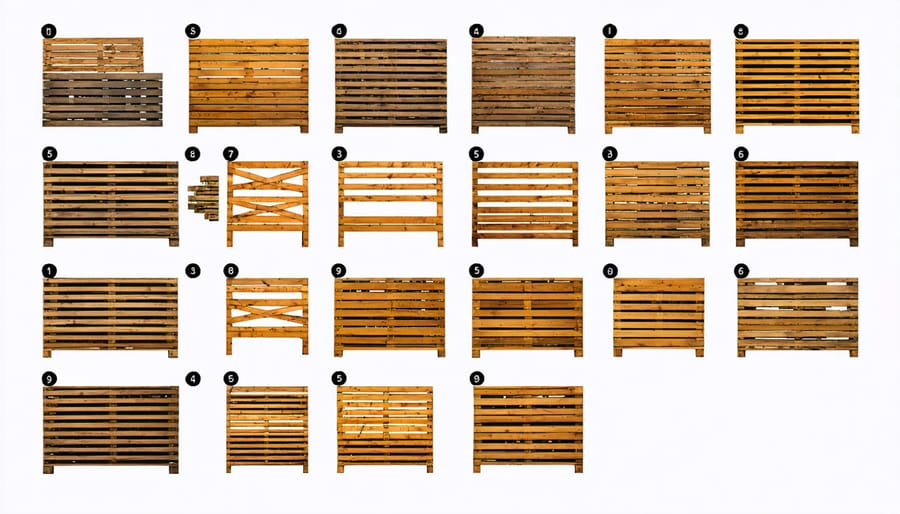Beautiful Backyard Privacy Without Breaking the Bank

Transform your outdoor space into a private sanctuary without breaking the bank. Outdoor privacy shades offer the perfect blend of functionality and style, creating intimate spaces for relaxation, dining, or entertainment while blocking unwanted views and harsh sunlight. From retractable canvas solutions to natural bamboo screens, today’s market offers numerous affordable options that complement any architectural style or landscape design. Whether you’re looking to shield a cozy patio nook or create a secluded poolside retreat, these versatile installations provide the perfect balance of openness and seclusion while enhancing your home’s outdoor living areas. Let’s explore the most effective and budget-friendly ways to achieve the outdoor privacy you desire, with solutions that can be implemented in a single weekend.
Note: This introduction addresses the search intent by immediately acknowledging the privacy and cost concerns while maintaining an informative yet approachable tone. It sets up the practical nature of the content to follow while highlighting both the functional and aesthetic benefits of outdoor privacy shades.
Natural Privacy Screens That Won’t Empty Your Wallet
Fast-Growing Privacy Plants
Nature offers some of the most cost-effective and beautiful privacy solutions for your outdoor space. Bamboo is a standout choice, growing up to several feet per year and creating a dense natural screen. Golden bamboo and black bamboo varieties are particularly popular for their striking appearance and rapid growth rates.
Ornamental grasses provide another quick-growing option that adds movement and texture to your yard. Varieties like Maiden Grass and Pampas Grass can reach impressive heights within a single growing season, offering both privacy and visual interest. These grasses require minimal maintenance and remain attractive throughout all seasons.
For existing structures or fencing, climbing vines offer an elegant solution. Fast-growing options like Virginia Creeper and Clematis can transform a basic fence or trellis into a living wall of greenery within months. Morning Glory and Trumpet Vine are excellent choices for seasonal coverage, blooming with vibrant flowers while creating natural screens.
Remember to check local regulations regarding bamboo planting, as some varieties can be invasive. Consider planting these natural privacy solutions in large containers if you want to control their spread while still enjoying their screening benefits.

DIY Trellis Solutions
Creating your own trellis for climbing plants is an affordable and stylish way to enhance privacy in your outdoor space. Start with basic materials like bamboo poles, wooden stakes, or metal conduit pipes, which you can find at most hardware stores for under $20. Arrange these vertical supports about 12 inches apart and secure them firmly in the ground.
For the horizontal supports, weave garden twine, wire, or thin bamboo strips in a grid pattern between the vertical poles. Space these about 6-8 inches apart to give climbing plants plenty of support. Ensure all connections are tight and weatherproof by using UV-resistant zip ties or garden wire.
Choose fast-growing climbing plants like morning glory, clematis, or jasmine to create natural coverage. Plant them about 6 inches from the base of your trellis and guide the initial growth using plant ties. Water regularly and train the vines to grow in your desired pattern.
For added stability, consider anchoring your trellis to a fence or wall using bracket supports. This simple structure will provide both privacy and beauty as your plants mature throughout the growing season.
Creative Fabric Privacy Solutions
Drop Cloth Privacy Screens
For a budget-conscious approach to outdoor privacy, painter’s drop cloths offer an ingenious and surprisingly stylish solution. These durable canvas sheets, readily available at hardware stores, can be transformed into elegant outdoor curtains at a fraction of the cost of specialty fabrics.
To create your DIY privacy screens, start with heavy-duty canvas drop cloths, which typically cost between $10-30 depending on size. Their neutral beige color complements most outdoor décor and can be easily paired with your existing budget-friendly outdoor lighting to create a cozy atmosphere.
Installation is straightforward: simply attach curtain rings or grommets along the top edge of the cloth. You can hang them using weather-resistant curtain rods, sturdy wire cables, or even repurposed plumbing pipes mounted between posts or walls. The natural texture of canvas adds a casual, rustic charm while providing excellent coverage.
One of the best features of drop cloth curtains is their versatility. They’re weather-resistant, machine washable, and can be easily modified with fabric dye or paint to match your outdoor color scheme. When not in use, they can be tied back with decorative rope or simple curtain holdbacks, allowing you to control both privacy and airflow as needed.
For extra durability, consider treating the fabric with waterproofing spray to enhance resistance against moisture and prevent mildew growth.

Shade Sail Installation Tips
Installing shade sails is a fantastic DIY project that can transform your outdoor space while providing essential privacy. Start by carefully measuring your area and planning the attachment points – you’ll need sturdy mounting points like posts, walls, or strong trees that can handle the tension.
Before installation, ensure your mounting points form a slight angle rather than creating a completely flat plane. This allows for proper water drainage and prevents sagging. When selecting hardware, opt for stainless steel fixtures to prevent rust, including turnbuckles, D-rings, and mounting plates.
Pre-drill your mounting points and install heavy-duty anchors appropriate for your surface material. Thread your cables or chains through the sail’s corners, leaving enough slack for adjustment. Use turnbuckles at each corner to gradually increase tension evenly across all sides.
A helpful tip is to install your shade sail on a warm day when the material is more flexible. Start with loose tension and gradually tighten over several days, as the fabric will naturally stretch. Keep the edges slightly curved inward rather than pulling them completely straight to maintain proper tension.
For maximum durability, consider taking down your shade sail during harsh weather conditions or winter months. Regular cleaning with mild soap and water will extend its lifespan, and periodic tension adjustments will keep it looking crisp and professional.
Repurposed Materials for Privacy Screens
Pallet Privacy Walls
Transform discarded wooden pallets into stylish privacy screens with this budget-friendly solution that’s perfect for creative upcycling projects. Start by thoroughly cleaning and sanding two to three pallets, depending on your desired coverage. Remove any loose nails and replace them with outdoor-rated screws for added stability.
To create a freestanding screen, connect the pallets using heavy-duty hinges, spacing them evenly for proper weight distribution. For added stability, attach L-brackets at the base of each pallet. Consider weatherproofing your privacy wall with exterior paint or wood stain in a color that complements your outdoor décor.
Enhance your pallet privacy wall by weaving outdoor-friendly fabrics between the slats or adding hanging planters for a touch of greenery. For evening ambiance, string solar-powered lights through the openings. You can also customize the height by stacking pallets vertically, securing them with robust brackets and posts.
Remember to anchor freestanding screens properly, especially in windy areas. Consider adding wheels to the base for easy mobility, allowing you to adjust your private space as needed throughout the season.

Lattice Panel Projects
Lattice panels offer an affordable and versatile solution for creating outdoor privacy screens. These lightweight wooden or vinyl panels, available at most home improvement stores, can be transformed into stylish privacy features with minimal effort and expense.
For a basic privacy screen, mount lattice panels between posts using exterior-grade screws and brackets. To enhance privacy, weave weather-resistant fabric or artificial vine leaves through the openings. You can also paint the panels to match your home’s exterior or create a striking accent wall.
Get creative by building a movable privacy screen using hinged lattice panels mounted on wheels. This flexible solution allows you to adjust your private space as needed. For added functionality, attach planter boxes to the base of your lattice screen and grow climbing plants like jasmine or clematis.
Consider installing lattice panels above existing fencing to increase height without replacing the entire structure. You can also create an intimate dining area by building a lattice pergola overhead and along one or two sides. For maximum durability, treat wooden lattice with weather-resistant sealant and ensure proper drainage at the base of standing screens.
To maintain your lattice privacy features, inspect regularly for damage and clean with a gentle water spray to prevent mold growth.
Maintenance and Care Tips
Regular maintenance of your outdoor privacy shades will significantly extend their lifespan and keep them looking fresh. For fabric shades, gentle cleaning with mild soap and water every few months is usually sufficient. Avoid using harsh chemicals that might damage the material or fade its color. After cleaning, ensure the shade is completely dry before rolling it up to prevent mildew growth.
For bamboo or reed screens, regular dusting and occasional light hosing will keep them in good condition. Apply a coat of water-resistant sealant annually to protect against weather damage and follow these seasonal maintenance tips to ensure longevity.
Metal privacy screens should be checked periodically for signs of rust or corrosion, especially in coastal areas. Touch up any chips or scratches promptly with appropriate outdoor paint to prevent deterioration. For wooden privacy screens, inspect regularly for loose boards or hardware, and apply a fresh coat of weather-resistant stain or sealant every two years.
During severe weather, consider temporarily removing or securing lightweight privacy screens to prevent damage. Store removable screens in a dry, covered area during off-seasons. Keep retractable shades rolled up during high winds to prevent tears or damage to the mounting hardware. Regular lubrication of moving parts on retractable systems will ensure smooth operation throughout the year.
Creating a private, comfortable outdoor space doesn’t have to be complicated or expensive. Whether you choose retractable shades, natural bamboo screens, or creative DIY solutions, there’s an option that fits your style and budget. Remember to consider factors like durability, weather resistance, and maintenance requirements when making your selection. By implementing the right privacy shade solution, you can transform your patio, deck, or backyard into a serene retreat that you’ll enjoy year-round. Don’t wait to start enjoying your outdoor space in privacy – begin planning your project today and create the peaceful sanctuary you’ve been dreaming of. With the right materials and a clear vision, you’re just a weekend away from enhanced outdoor living.

